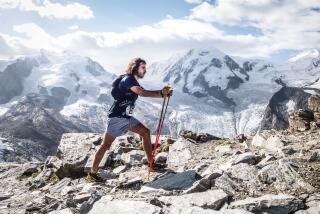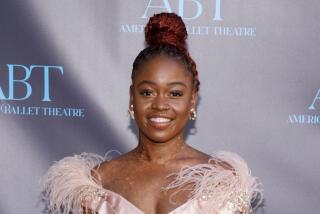LEADING LIGHT : Biathlon King George Pierce of Thousand Oaks Carries Torch for Fledgling Sport
- Share via
There is nothing more difficult to take in hand, more perilous to conduct, or more uncertain in its success, than to take the lead in the introduction of a new order in things.
--Machiavelli
An athlete who looks beyond Yogi Berra for inspiration? Yes, George Pierce actually tapes Machiavellian aphorisms to the living room wall of his Thousand Oaks home. And even though Machiavelli didn’t have sports in mind when he wrote those words nearly 500 years ago, Pierce thinks they apply to him.
“I’m pioneering a new movement in sports,” says Pierce, the reigning king of the biathlon, a sport that has been around for only about four years. It’s the desert version of the triathlon, a three-part race that includes running, cycling and swimming. There is no swimming in a biathlon, but that’s not the only difference between the sports. Champion triathlete Dave Scott makes $20-$30,000 for winning an Iron Man competition--which he did for six consecutive years--but Pierce’s victory was only worth $1,500.
Last February in Palm Springs, Pierce finished ahead of 500 athletes in the Desert Princess competition, considered the world biathlon championship. He did a 10K run followed by a 62K bike race and another 10K run in a combined time of 2 hours, 36 minutes, and 55 seconds. Aside from money, he was rewarded with his picture on the cover of the March issue of Competitor Magazine, which called him “The Demon of the Desert.”
A 6-foot-4 blond with a flattop, Pierce cuts an imposing figure on any surface. He is most often seen in the Santa Monica Mountains, slicing across Mulholland Drive on his Diamond Back mountain bike for three to five hours a day. He also runs almost every day for 90 minutes in the hills behind his home and manages to get in seven hours of swimming every week at a private swim school.
Pioneering a sport is a full-time effort, but it isn’t making him rich. “My wife Valerie supports me emotionally and financially,” says Pierce, who’s had to work in a warehouse to make ends meet. “Without her, I wouldn’t be where I am. It took a team effort.”
Valerie, a recruiter for an employment agency, also acts as her husband’s agent.
“Right now I have to do clerical work at a law firm to pay the rent,” says Pierce, who’s also getting his own marketing consulting firm off the ground.
Pierce has an MBA from the University of Chicago, “a real intense school” noted for churning out eggheads, not world-class athletes. He met Valerie when they were undergraduates at Denison University in Ohio. When he wasn’t pursuing his major in economics, he was on the lacrosse and soccer teams.
“I’ve pretty much been running my whole life,” says Pierce, who also played lacrosse and soccer in high school. Working in Boston in the early 1980s, he competed in marathons and 10Ks but then “got burned out on them. Running didn’t excite me anymore.”
In 1982, he happened to read a Time magazine article on John Howard, a triathlon pioneer who won that year’s Iron Man in Hawaii. He was excited again. Not only did the triathlon challenge an athlete to perform beyond his limitations, it didn’t draw the massive fields that marathons did.
“I started to do cross-training,” Pierce says, “and gear up for the Iron Man in ’83.” That year, there were some 20 triathlons on the East Coast, but they were dominated by athletes from the West Coast, where the triathlon movement first began. Pierce was able to qualify for and take part in the ’83 Iron Man. The 1,200 competitors had to swim 2.4 miles in the open ocean, cycle 112 miles over hills and then run a marathon. Pierce did it in 12 1/2 hours, placing in the top third of the finishers.
“It was an odyssey to me,” says Pierce, who hasn’t competed in the Iron Man since.
It seems ironic to Pierce that his move to Southern California in 1986, to work as a product manager for a bicycle distributor, coincides with the rising popularity of the biathlon, which was originated to give athletes a winter alternative to the triathlon.
Pierce read about the Desert Princess race in Triathlete Magazine and entered. He finished second in his age group and 25th overall out of 400 racers. Last year, his best finish was a second. But his chances of winning the world title race were ended by a flat tire.
After quitting the bike company in May, 1987, to market a customized insole called Solemates, Pierce began training full time. In the past two years, he has entered four triathlons and 15 biathlons, with several bike races and 10Ks thrown in.
“I compete in the tris because they’re more highly publicized and draw a better field of athletes,” Pierce says. Triathlon prize money is also a big factor. “The prize money in all biathlon races in the U.S. is not equal to one major triathlon, to put it in perspective.”
Pierce sees the biathlon as more a “life style” than a sport. “It’s a way of living and understanding my life,” he says. But he also sees himself as a “Neanderthal” taking part in a “primal sport where there’s not much money or glory, just your personal effort against a clock. The only limiting factor is you. At the moment of truth,” he says, “how far can you go? How far can you push yourself?”
At the end of this month, Pierce will be pushing himself in Queensland, Australia, competing for the $20,000 first prize in the World Cup Triathlon. “I’m in peak form,” he says, “but I can get faster.
“This has to be your whole life,” he says. “But training is so satisfying.”


